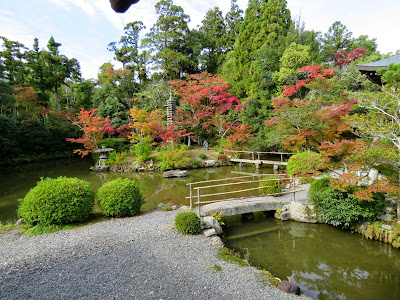
Seiryo-ji Temple that is commonly known as Saga Shaka-do, is located in Saga District of Ukyo-ku at West Kyoto. It is a time-honored temple of Pureland Sect of Buddhism. The origin of Seiryo Temple was Seikaji Temple which was converted from a mountain villa Seikakan of a famous poet and statesman in Heian period (794-1185) named Minamoto-No-Toru. The place was also the site where the model of Hero Hikaru Genji in Japanese Literature Tale of Genji located. In year 945, a new temple was restored on the site where an Amitabha Hall was found, and a life-sized image of Shakyamuni Tathagata was enshrined in the hall. The Temple was then better known as Sagashaka-do. The name of Seiryoji was officially applied to the temple in 985 when the high priest Chonen brought back from China an imitation image of a legendary Udayana Buddha made by Indian King Udayana during Buddha's lifetime. The statue of Rev. Chonen was erected in the temple grounds near its huge entrance gate.



The Seiryo-ji Temple was named after the name of China's famous Buddhist sacred mountain Wutaishan that sometimes is also known as Qianliang-shan. It was constructed as a replica of Wutaishan when first built. I had visited China's Wutaishan two years ago and I found that the existing temple site of Seiryo had nothing to compare to the China's Wutaishan, which composed of about 80 temples in its valley vicinity that need 3-4 days to tour around.


The wooden structures of its imposing huge main entrance gate.



The Tahoto Pagoda standing in the front compound of the Temple Complex looks unique and elegant.


The main shrine hall that first constructed in year 945 had been destroyed in wars and fires. The present building was restored in 1701 under the initiative of the 5th Tokugawa Shogun Tsunayoshi and his mother Keishoin.


The sandalwood image of standing Shakyamuni Buddha that Rev. Chonen brought back on a pilgrimage trip from Sung Dynasty of China (960-1279) was now enshrined in the main hall Shakado. The 162cm tall image is a national treasure of Japan and one of the three most important Buddhist images in the country. Since the discovery found in 1953 that the statue aspects as a human phantom with ear holes connected to nasal cavity and internal organs were made from silk, it was addressed as Ikimi Nyorai, a living Shikyamuni Tathagata. We were highly blessed to have an opportunity to closely paying homage to an ancient Buddha Image which was believed to be the oldest of this kind in the world. It was opened for public on the 8th of every month.



Illustration map and history of Temple Seiryo-ji



A hall of transcription


The covered wooden corridor that linked the main shrine hall to the gardens and other temple grounds. The corner of precinct with a stone tori gate are where the tombs of Rev. Chonen, Statesman Minamoto-No-Toru, Emperor Saga and Empress Danrin located.



A pair of huge old brass Caldrons placed by the side of the gardens were carved with the name of Wutaishan. Was it an artifact of this Wutaishan or was it referred to its origin from China Wutaishan, I confused.





The two outstanding rocks placed in front of a hall in the garden, are carved with the image and name of Amitabha Buddha.


There are two beautiful gardens in Seiryo-ji temple ground and the spectacular can be viewed while strolling along its covered corridor.


The pond, the rock, the bridge, the stone lantern and pagoda with the bright foliage, are the main role players in this spectacular sight behind the main buildings.




The Hall of Benten-do is the most outstanding and gorgeous structure in the garden.


We were immensely immersed at this wonderful scenery!














The small hall near the Moss Garden is the museum where most of the temple treasures are exhibited. Many of them are national treasures and important cultural properties, including Buddhist Images, calligraphy and drawings.






Striking autumn leaves in Moss Garden.








Though in comparison to other temples at Arishiyama, Seiryo-ji is not too popular, it is still worth a visit. It is a place away from the crowds, allowing you to quietly strolling according to your own pace, a place that offers you lots of historical artifacts and beautiful sight of nature from its decent garden.





No comments:
Post a Comment